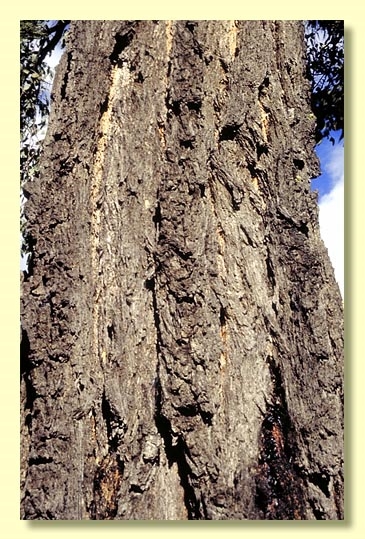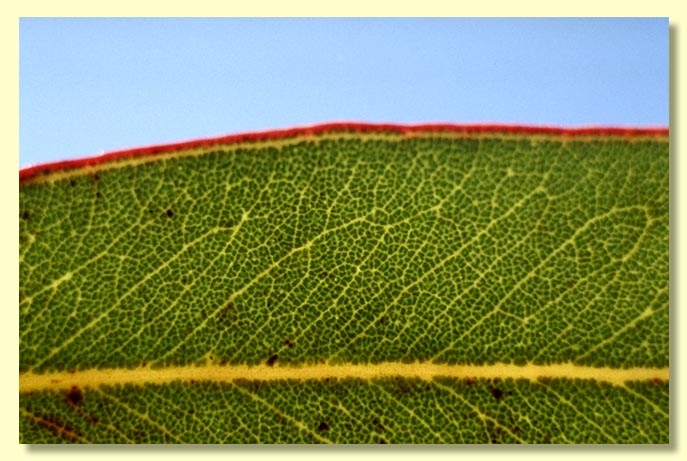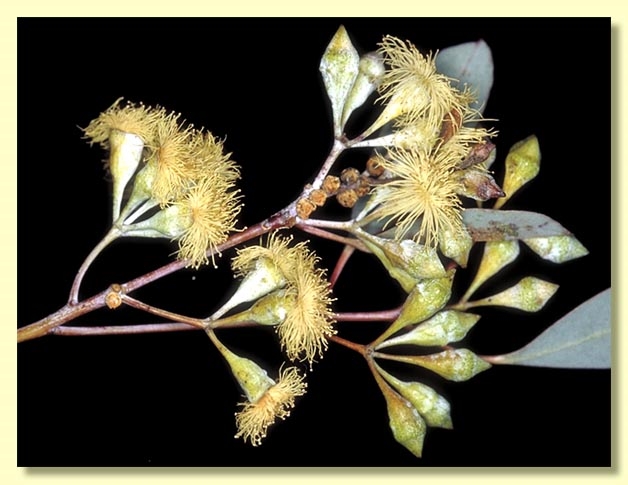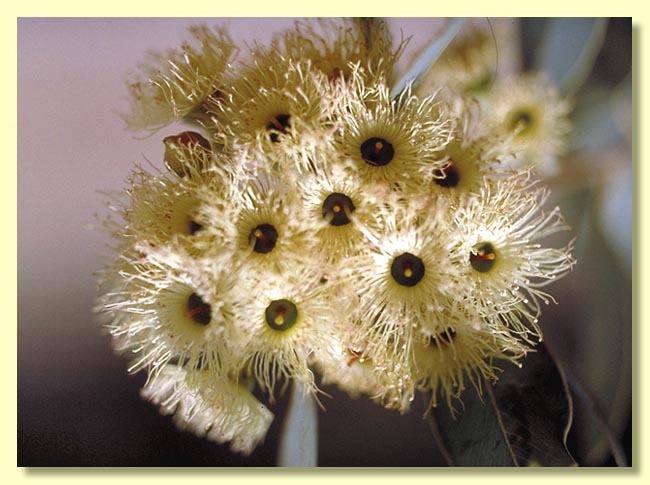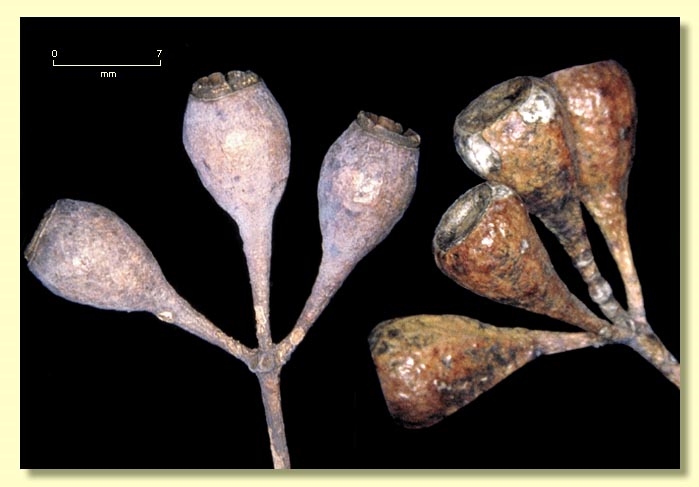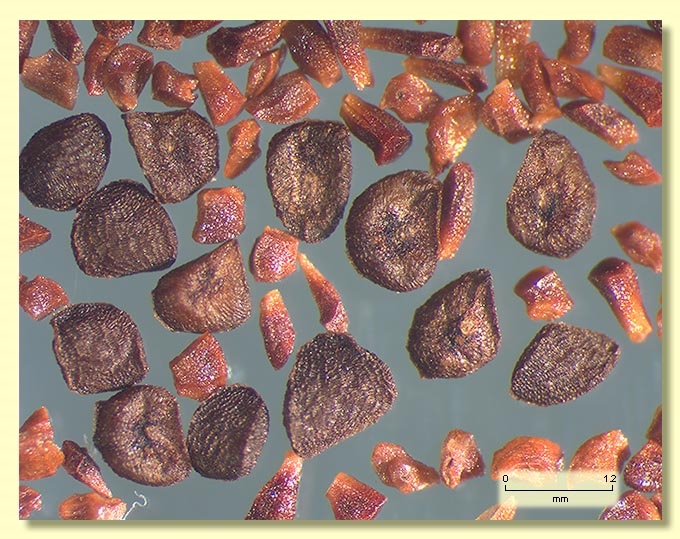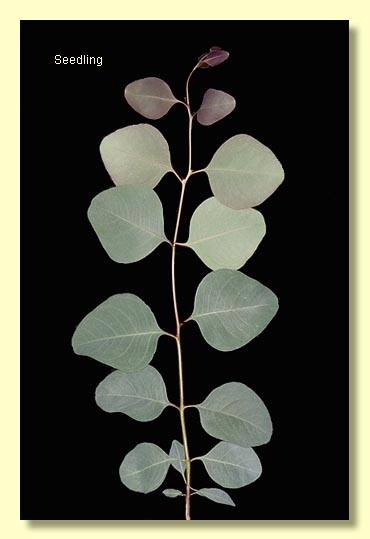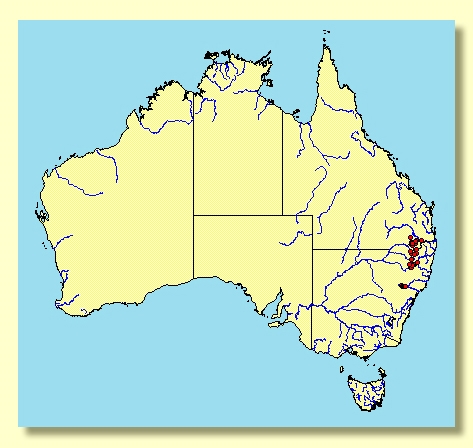Euclid - Online edition
Eucalyptus caleyi subsp. caleyi
Classification
Eucalyptus | Symphyomyrtus | Adnataria | Terminales | Rhodoxylon | Concolores
Nomenclature
Eucalyptus caleyi Maiden, Proc. Linn. Soc. New South Wales 30: 512 (1906) subsp. caleyi.
T: Howell, NSW, Aug. 1905, J.H.Maiden & J.L.Boorman s.n.; lecto: NSW; isolecto: G, K, L.
E. leucoxylon var. pallens Benth., Fl. Austral. 3: 210 (1867); E. sideroxylon var. pallens (Benth.) Rehder, Cycl. American Hort. 2: 552 (1990). T: New England, NSW, C.Stuart s.n.; holo: K. (also placed in synonomy under E. sideroxylon fide K.D.Hill & L.A.S.Johnson, Telopea 4 (2) 245 (1991)).
E. coerulea R.T.Baker & H.G.Sm., Res. Eucalypts 2nd edn, 271 (1920). T: Central Tablelands, Murrumbo, NSW, Dec. 1893, R.T.Baker s.n.; lecto: NSW.
T: Howell, NSW, Aug. 1905, J.H.Maiden & J.L.Boorman s.n.; lecto: NSW; isolecto: G, K, L.
E. leucoxylon var. pallens Benth., Fl. Austral. 3: 210 (1867); E. sideroxylon var. pallens (Benth.) Rehder, Cycl. American Hort. 2: 552 (1990). T: New England, NSW, C.Stuart s.n.; holo: K. (also placed in synonomy under E. sideroxylon fide K.D.Hill & L.A.S.Johnson, Telopea 4 (2) 245 (1991)).
E. coerulea R.T.Baker & H.G.Sm., Res. Eucalypts 2nd edn, 271 (1920). T: Central Tablelands, Murrumbo, NSW, Dec. 1893, R.T.Baker s.n.; lecto: NSW.
Description
Tree to 30 m tall. Forming a lignotuber.
Ironbark to small branches, grey, brown or black, branchlets glaucous or non-glaucous.
Juvenile growth (coppice or field seedlings to 50 cm): stem rounded or square in cross-section, often glaucous; juvenile leaves always petiolate, opposite for 3 to 6 pairs then alternate, orbicular, ovate or deltoid, 3–7 cm long, 1.7–7 cm wide, base tapering to petiole or truncate, blue-grey or glaucous.
Adult leaves alternate, petiole 1–2 cm long; blade ovate to lanceolate, 4.5–11 cm long, 1.8–4.5 cm wide, base tapering to petiole, concolorous, dull, blue-grey to glaucous, side-veins usually greater than 45° to midrib, densely to very densely reticulate, intramarginal vein parallel to and just within margin or well removed from it, oil glands intersectional or obscure.
Inflorescence terminal compound, sometimes with axillary umbels also, peduncle erect or pendulous, 0.9–2 cm long, buds 7 per umbel, pedicels 0.5–1.2 cm long. ature buds diamond-shaped to ovoid to obovoid to sometimes ± pear-shaped, 0.7–1 cm long, 0.4–0.5 cm wide, glaucous, scar present, operculum conical, stamens inflexed, with outer staminodes, anthers adnate, positioned obliquely at filament tip, cuboid, dehiscing by terminal pores, style long, stigma blunt or pin-head shaped, locules 3 or 4, the placentae each with 4 vertical ovule rows. Flowers white.
Fruit pedicellate (pedicels (0.2)0.5–1.4 cm long), barrel-shaped or obconical, 0.6–1 cm long, 0.4–0.8 cm wide, not ridged, ribbed or angled longitudinally, glaucous or non-glaucous, disc descending, valves 3 or 4, enclosed.
Seeds brown or grey, 1–2 mm long, flattened-ovoid, often pointed at one end, dorsal surface shallowly pitted, hilum ventral.
Cultivated seedlings (measured at ca node 10): cotyledons bilobed; stems square in cross-section or slightly winged, glaucous or not; leaves always petiolate, opposite for 2 to 5 nodes then alternate, deltoid, ovate or orbicular, 4.5–7 cm long, 4.5–7 cm wide, base truncate to tapering, apex rounded, dull grey-green or slightly glaucous.
Ironbark to small branches, grey, brown or black, branchlets glaucous or non-glaucous.
Juvenile growth (coppice or field seedlings to 50 cm): stem rounded or square in cross-section, often glaucous; juvenile leaves always petiolate, opposite for 3 to 6 pairs then alternate, orbicular, ovate or deltoid, 3–7 cm long, 1.7–7 cm wide, base tapering to petiole or truncate, blue-grey or glaucous.
Adult leaves alternate, petiole 1–2 cm long; blade ovate to lanceolate, 4.5–11 cm long, 1.8–4.5 cm wide, base tapering to petiole, concolorous, dull, blue-grey to glaucous, side-veins usually greater than 45° to midrib, densely to very densely reticulate, intramarginal vein parallel to and just within margin or well removed from it, oil glands intersectional or obscure.
Inflorescence terminal compound, sometimes with axillary umbels also, peduncle erect or pendulous, 0.9–2 cm long, buds 7 per umbel, pedicels 0.5–1.2 cm long. ature buds diamond-shaped to ovoid to obovoid to sometimes ± pear-shaped, 0.7–1 cm long, 0.4–0.5 cm wide, glaucous, scar present, operculum conical, stamens inflexed, with outer staminodes, anthers adnate, positioned obliquely at filament tip, cuboid, dehiscing by terminal pores, style long, stigma blunt or pin-head shaped, locules 3 or 4, the placentae each with 4 vertical ovule rows. Flowers white.
Fruit pedicellate (pedicels (0.2)0.5–1.4 cm long), barrel-shaped or obconical, 0.6–1 cm long, 0.4–0.8 cm wide, not ridged, ribbed or angled longitudinally, glaucous or non-glaucous, disc descending, valves 3 or 4, enclosed.
Seeds brown or grey, 1–2 mm long, flattened-ovoid, often pointed at one end, dorsal surface shallowly pitted, hilum ventral.
Cultivated seedlings (measured at ca node 10): cotyledons bilobed; stems square in cross-section or slightly winged, glaucous or not; leaves always petiolate, opposite for 2 to 5 nodes then alternate, deltoid, ovate or orbicular, 4.5–7 cm long, 4.5–7 cm wide, base truncate to tapering, apex rounded, dull grey-green or slightly glaucous.
Flowering Time
Flowering has been recorded in April, June, September, October and November.
Notes
Eucalyptus caleyi is a small to medium-sized ironbark tree species of scattered distribution, usually on stony sites, from near Denman in the Hunter Valley, New South Wales, north through the central and northern tablelands of New South Wales to the Inglewood–Warwick–Girraween area of far south-eastern Queensland. Leaves, buds and fruit are usually glaucous, the pedicels are long and slender, and the fruit are narrow at the top forming a barrel shape.
Within its sub-group, E. caleyi should only be confused with E. corynodes, both species possessing glaucous adult leaves. All other members have non-glaucous green adult leaves. E. caleyi can be separated from E. corynodes by normally having ovate adult leaves and orbicular to deltoid to ovate juvenile leaves (adult and juvenile leaves lanceolate in E. corynodes). E. scopulorum, a recently described species restricted to the Nymboida National Park on the Northern Tablelands of New South Wales, must also be very close to E. caleyi. Apart from being completely non-glaucous, it differs further by having elliptical juvenile leaves which are usually narrower than those in E. caleyi (E. caleyi normally with orbicular to deltoid to ovate juvenile leaves).
Within its area of occurrence there is really only one other ironbark (from another sub-group) with glaucous adult leaves that could be confused with E. caleyi and that is E. melanophloia. It differs by having buds with stamens all fertile and irregularly flexed and opposite, sessile to rarely very shortly petiolate adult leaves. (Adult leaves alternate with long slender petioles in E. caleyi.)
There are two subspecies:
E. caleyi subsp. caleyi
This subspecies has the more extensive distribution from Muswellbrook, New South Wales north to the Inglewood–Warwick–Girraween area in south-east Queensland. The buds and fruits are round in cross-section.
E. caleyi subsp. ovendenii
This subspecies is restricted in its distribution to west of Tenterfield, northern New South Wales, on more elevated sites. The buds and fruits are distinctly square in cross-section.
Eucalyptus caleyi subsp. ovendenii is listed as "Vulnerable" under the Australian Government Environment Protection and Biodiversity Conservation Act 1999 (EPBC Act). Further information may be found at this web address:
http://www.environment.gov.au/cgi-bin/sprat/public/sprat.pl
MORE ABOUT IRONBARKS
Within its sub-group, E. caleyi should only be confused with E. corynodes, both species possessing glaucous adult leaves. All other members have non-glaucous green adult leaves. E. caleyi can be separated from E. corynodes by normally having ovate adult leaves and orbicular to deltoid to ovate juvenile leaves (adult and juvenile leaves lanceolate in E. corynodes). E. scopulorum, a recently described species restricted to the Nymboida National Park on the Northern Tablelands of New South Wales, must also be very close to E. caleyi. Apart from being completely non-glaucous, it differs further by having elliptical juvenile leaves which are usually narrower than those in E. caleyi (E. caleyi normally with orbicular to deltoid to ovate juvenile leaves).
Within its area of occurrence there is really only one other ironbark (from another sub-group) with glaucous adult leaves that could be confused with E. caleyi and that is E. melanophloia. It differs by having buds with stamens all fertile and irregularly flexed and opposite, sessile to rarely very shortly petiolate adult leaves. (Adult leaves alternate with long slender petioles in E. caleyi.)
There are two subspecies:
E. caleyi subsp. caleyi
This subspecies has the more extensive distribution from Muswellbrook, New South Wales north to the Inglewood–Warwick–Girraween area in south-east Queensland. The buds and fruits are round in cross-section.
E. caleyi subsp. ovendenii
This subspecies is restricted in its distribution to west of Tenterfield, northern New South Wales, on more elevated sites. The buds and fruits are distinctly square in cross-section.
Eucalyptus caleyi subsp. ovendenii is listed as "Vulnerable" under the Australian Government Environment Protection and Biodiversity Conservation Act 1999 (EPBC Act). Further information may be found at this web address:
http://www.environment.gov.au/cgi-bin/sprat/public/sprat.pl
MORE ABOUT IRONBARKS
Origin of Name
Eucalyptus caleyi: after George Caley (1770–1829). George Caley was a botanical collector who, with the financial assistance of Sir Joseph Banks, collected extensively in New South Wales between the years 1800–1810. It is recorded of him that had his party not refused to proceed he may have been the first man to cross the Blue Mountains.
Copyright © CANBR 2020, all rights reserved.

Web edition hosted at https://apps.lucidcentral.org/euclid

